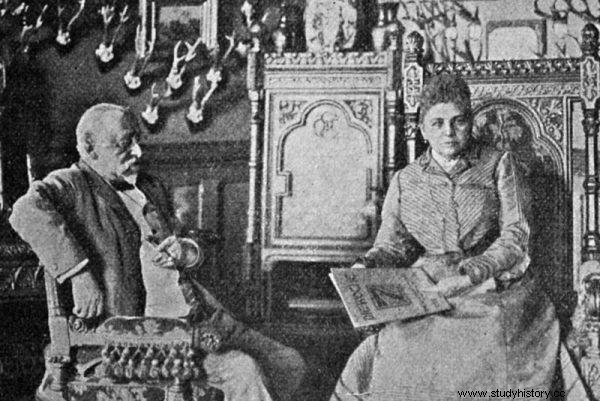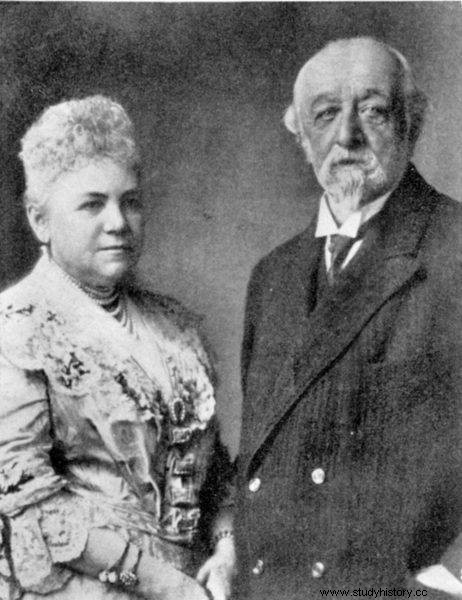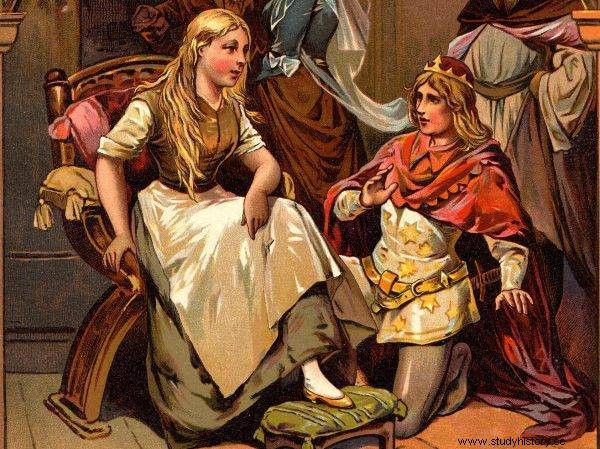History doesn't always have to be serious. Sometimes he has the right to extraordinary, even magical events. Do you know the fairy tale about Cinderella? It really happened in Silesia.
Joanna Gryzik, known as the Silesian Cinderella, was born in 1842 in a poor family. Her father worked in a zinc mine, and her mother was a servant on the estate of Karol Godula - one of the largest industrial tycoons in Silesia. Unfortunately, fate treated little Joanna in a cruel way . When she was only three years old, her father died - the main breadwinner who barely made ends meet. The desperate mother, deprived of the resources to support the girl, did not want to take care of her any longer. In this way, Joanna was taken into the care of other servants at Karol Godula's estate.
Demon from Ruda Śląska
Godula was one of the richest industrialists in Silesia. In the second half of the 19th century, the value of his fortune was estimated at 2 million thalers (for comparison - the average worker earned about 150 thalers a year). This considerable property included 19 calamine mines, 40 hard coal mines and 3 zinc smelters. Godula was also a landowner. It used to belong to villages, and today districts of Ruda Śląska and Mikołów:Paniowy, Orzegów and Szombierki. Despite his enormous wealth and flair for business Godula was considered a weirdo, a loner and an extremely mysterious gentleman . There were rumors that he had been mugged and mutilated in his youth. His eye was torn out then. His face was scarred. To make matters worse, he was limping on one of his legs. No wonder that children were threatened with it. He himself avoided company.

Goduli Palace in Szombierki
In creating his image, he was not helped by the numerous chemical experiments he carried out on his property. It was because of them that he became a charlatan, and people often called him a demon from Ruda Śląska . He himself fueled the rumors. Locked in his mansion, he rarely appeared in public.
An amazing friendship
However, children see the world completely differently. The seemingly terrible and repulsive appearance of Karol Godula did not prevent the few-year-old Joasia Gryzik. As the only child on the property, she was not afraid of the old gentleman. Apparently, one day she even gave him a bouquet of flowers she picked herself. Both the gesture and the directness of the girl aroused the sympathy of the old man, who decided to repay him.

Joanna Gryzik was hailed the Silesian Cinderella
He decided to change her fate. He wanted to ensure a future for her that was different from the role of a servant in the estate for which she was prepared by the babysitters. Noting Joasia's above-average resoluteness and intelligence, he decided to pay for a private tutor for her.
Karol Godula never started a family and did not get involved with anyone. When in July 1848 the news of his death came from Wrocław, where he had gone for treatment, everyone wondered who would get the huge fortune. There were many people willing. Among them were Godula's nephews, to whom he surprisingly saved only 200,000 thalers, which in the face of all his fortune was a symbolic amount.
A testament that surprised everyone
According to the will , the fortune, considered one of the largest in Silesia, fell entirely to 6-year-old Joanna Gryzik . Godula appointed his closest associates as guardians. First of all, a good friend and lawyer of Maksymilian Scheffler. The latter decided to place the girl in the Ursuline convent in Wrocław, where she continued her education. It was an extremely sensible decision. The other heirs tried to overturn the will and get rid of the uncomfortable baby.

Joanna Gryzik with her husband
After graduation, the teenage Joanna moved with the Scheffler family in his villa in Wrocław . Thanks to her guardian's efforts, on October 6, 1858, the girl was ennobled (knighted) by Frederick William IV Hohenzollern himself - King of Prussia. Her surname was changed from Gryzik to von Schomberg-Godula. It was also given an unusual coat of arms, in which there was a kuple (mining symbol) and the colors of Upper Silesia - blue and gold.
In November 1858 married Count Hans Ulryk Schlaffgotsch from Cieplice . He came from a well-known in Europe, but rather impotent aristocratic family. The ceremony took place in Bytom. The arranged marriage turned out to be very successful. A year later, the couple bought a palace in Kopice, which became their residence and seat of the newly created so-called Upper Silesian line of the Schaffgotsch family.
The couple had a son and three daughters. Interestingly, Joanna Schaffgotsch was recognized as an adult, and thus able to dispose of the property inherited from Karol Godula, only in 1865, i.e. a year after the birth of her last daughter. As it turned out, the woman brilliantly managed the fortune entrusted to her . The mines belonging to it were quite profitable. Joanna was famous for her charity work and numerous foundations. On her initiative, a dozen or so churches were built in Silesia, many schools, and numerous hospitals. In the years 1903–1908 she founded the Monastery of the Franciscan Fathers in Ligota-Panewniki. It still works today.
History forgotten in ruins
Joanna Schlaffgotsch died in 1910 in Kopice. She was buried in the local mausoleum. Unfortunately, its story did not end there. After World War II, the Schlaffgotsch mausoleum was plundered by Red Army soldiers. The profaned corpses of family members were buried in a modest mass grave. The extraordinary story of Joanna Gryzik is forgotten.

The extraordinary story of Joanna Gryzik is forgotten
The only memento of the Silesian Cinderella is the neo-baroque palace in Kopice. Surrounded on three sides by extensive ponds, was considered one of the most beautiful 19th-century residences in Silesia . Unfortunately, only its ruins have survived to this day. The war treated him kindly. It was not until the 1950s that its devastation and looting began. Sadly, it is often in the majesty of the law. On October 7, 1956, the inhabitants of Kopice saw clouds of thick smoke. Unknown perpetrators set fire to the palace by releasing water from the pond.
From that moment on, the ruins, devoid of a roof and some ceilings, were of no interest to almost anyone. Maybe with the exception of the lesser thieves and party goers who took away or destroyed the preserved remains of sculptures and stucco. Later, the palace was just unlucky. Further promising reconstruction and restoration of former glory investors withdrew, destroying and robbing the ruins even more. However, the inhabitants of Kopice believe that the day will finally come when the former residence of the Schlaffgotsch family will regain its splendor and become an architectural jewel of 100 years ago.
Bibliography:
- Gabriela Anna Kańtor, Silesian Cinderella, Katowice 2020.
- A. Kuzio-Podrucki, Schaffgotschs. The changing fate of the Silesian aristocracy , Bytom 2007.
- I. Twardoch, From the history of the Schaffgotsch family , Ruda Śląska 1999.
